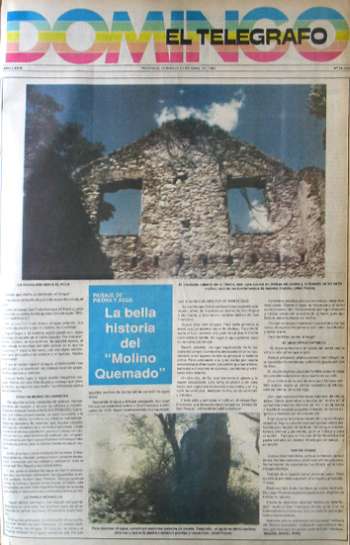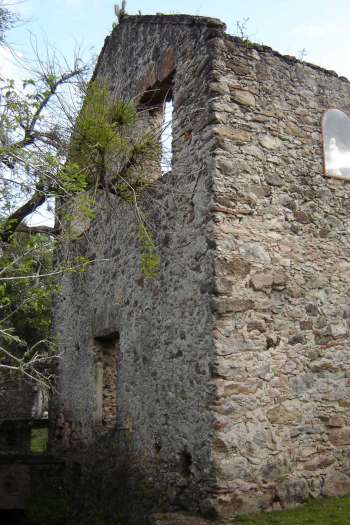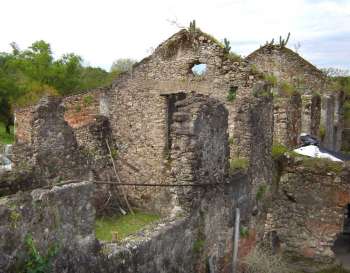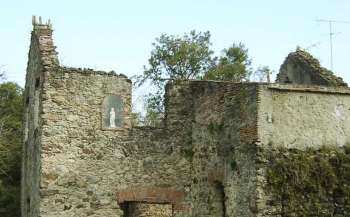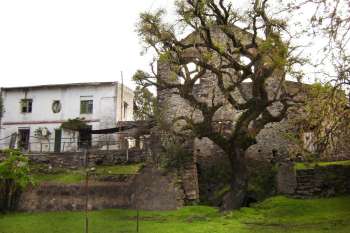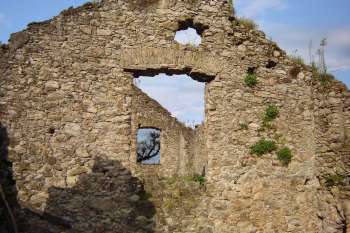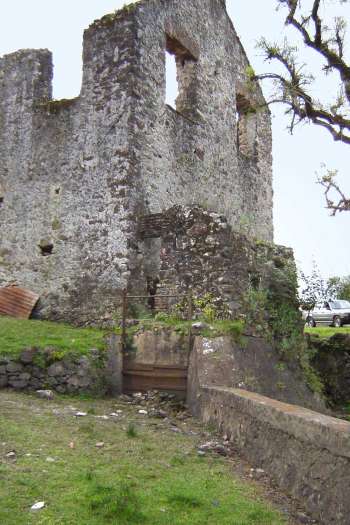The wheel that milled the water.
“Now that the autumn he goes milling the
time”.
There is as a dream of peace and of memories in
that place.
Next to the stream San Francisco that there traces
their arch surrounding the hill where they are the ruins of the“Burn
Mill ”.
There the man knew how to tame the potent water,
with the stone control and for the progress and the utility .
That place and the name that was with sign of marked
fire in and! he speaks popular. For that accident, common in the
mills of that time, the place forgot the name of the beautiful stream
in which leans back. And he passed to call himself, with that admiring
sign that you frame the name and the epithet: Burnt mill! .
And the fire overcame this way to the water, the
smut shone what a the sun and the boil of the work ceased suddenly,
made ashy and silence.
It was a beautiful place and it continues being
magnificent landscape. Now with that tint of peace and serenity
that it puts the autumn, although it is not autumn. The difference
resides in the silence.
An entire world of carts
Of that time, loaded with grains, meekness of oxen
and to incite of whistles and noise of voices. It pauses and push
toward the Molino Perosio. Carts with mules become
obstinate in going up the hill, and the flower of the lips cartwrights
singing in the morning. Some caravan of carts that arrived loaded
with wheat for the road that she came from Esperanza. (Pretty name
that of that population, for a work with earth roots and aspirations
of dreams!) This way, in big complaining carts the matter was transported
it prevails for the flour milled in that mill .
Next to the stream and in the eddy of the hill.
Strategically located, because it was a work heart. Known by their
work and quality in the whole north of the Black River and their
adjacent ones.
And there next to the hug of San Francisco's water
that today contemplates silent, it awaited them Don Juan Perosio's
wide smile. Pleasant smile as the flour and good as the bread. He
had been the initiator of this whole magnificent work of the wheel
that milled the water so that the flour grew in flower.
The hydraulic force
That Mill of the Sacred one, San Miguel, of which
will speak in another note, was the first step in the one on the
way to the flour that the visionary Juan Perosio.
The second great step, the culmination of its dream,
was San Francisco's Mill. In both mills, the pulse was the water.
The muscle, the wheel and the push were in the water, they came
from her.
For that reason those mills of flour had heart of sweet water .
Looking for the water and the appropriate place,
Don Juan Perosio settled down on the San Francisco at the beginning
of 1870. That establishment was baptized with the name of Mill
de San Roque.
To dominate the water, it built enormous stone
walls. Then ... the water opened up road another time and envelope
the stone plants and memories they grew.
It is related that Don Juan Perosio looked for
the appropriate place a lot, before transferring his mill of San
Miguel or of the Sacred one, to San Francisco's new establishment.
It looked for the water above all. To give him
power it braked it with an enormous wall of stones. To dominate
her he made it travel a great curve that him same it dug among the
mount. It achieved this way the potent water, but in dominated eddy.
It looked for, also, a halfway place of the city
and of the field.
The industry should be in the field, near to the places where the
matter takes place it prevails. But connected to the great city
for where the market was channeled. A road that was passable for
the transporting in carts, drays and lighter vehicles. A high place
in short that it dominated the stream and the surrounding region.
A stone hill or of hard rough that supported the heavy machinery
and the to go and to come from vehicles, shot animals, constructions
and works.
And all this and even more it found it in the stream
San Francisco, to the height where it built their “Mill of
San Roque”. There it also found the beauty!
The practical beauty, to be able to work without
traffic problems. Where the water leaned back to the hill like affectionate.
So affectionately that it was able to catch it and to bring it,
like with the caress of the hand, so that she made walk the wheel
of the mill.
And then she scattered in motive force for the
veins of that machinery, with eddy rumor and flavor to bread. But
the fire was also!
The old floury occupation
It doesn't care a lot if the cereal was before
the vine or the wine before the bread. Both vital foods were born
of the miracle of the human necessity that heightened the gift's
of God grace .
Yes, from the man's first step on the earth the
cereals were in the door of their life. In the threshold of Don
Juan Perosio's life it was also from a first moment, the production
of flour, soul of the wheat.
Don Juan Perosio was experienced floury, of italic
origin. He had learned the lesson of the mill in the I hum maternal
riverside of the Pó. And in the one hurted and their father's
fruitful task, farmer of lands avoids and miller in the valley of
the river.
He brought their lesson here this way suck and
their affection for the mill. Here to these lands “sanduceras”
where so many Italians brought so much well. Lands that were then
wide and deep, for the work and for the dream... Times in those
that the son inherited of the father farmer, a mystic interest for
the work... and a plow!
With a plow
With their melodious grill, because the wood took
it out of the near mounts, he opened its first furrows. Seed of
hope fructified in the blond miracle of the wheat. Work hard, watered
by the sunny perspiration. But it not only allowed him to survive
but to project and to create.
Don Juan could this way, to fructify his dream
miller. Don Juan Perosio: specialist miller. Future millers' teacher.
From their laborious seat of the “Mill of San Roque”.
next to the San Francisco, where, next to him, other millers were
formed. It is a history that we will continue developing. While
now I contemplate this beautiful still of the “Burnt Mill”,
the soul of that old mill that he washes their memories next to
the river San Francisco.
Miguel Ángel Pías.
The burnt mills
Of the same school of millers, the first mill that
we already said called himself of the Sacred one, or San Miguel,
the big millers sanduceros that laid the foundation among us this
important industry came out. There they were formed as operatives,
among other Juan Perosio, José Molinari and Cesar Fraschini.
They learned in the experience accumulated in so
many days of to work the wheat and to elaborate the flour. In the
first times, times so hard as the stones of their mills. So hard
and difficult that almost all the floury mills finished burnt. For
several reasons that they finished in insoluble problems. The use
of the combustible wood-coal that presupposed the danger of the
open fire.
Then, the later change to the use of the vapor,
the constructions based on wood, the absence of near elements to
combat the fire... Anyway, Perosio was founded and he worked intensely
in its mill of San Francisco, later we will give more details. But,
let us say it from already, their mill finished burnt. And of there
the name with which he baptized him the town. But the only one that
died from the fire was not . Also in the streets “Entre Rios”
and Washington, Don Francisco Gutiérrez Zorrilla built his
mill, called “Mill of Ugly” and also Mill of “Santa
Carmen”. It also finished burnt.
José Molinari founded another mill in the
outskirts of the city, then: in the street “Treinta y Tres
Orientales” and “Rio Negro”.Mill that also finished
burnt and that people baptized with the name of “Mill of the
Mystery”, for other reasons that we will explain in her moment
.
The ruins of both mills are today in our city and
they have been used as trade, housings, carpentries and until temples.
But people don't call them with the nickname of “burnt mill”.
Perosio burns yes, alone to him he has baptized him to him a: “The
burnt mill”
The first times of San Francisco's Mill, of Don Juan Perosio, era of water, hydraulic, like we
have pointed out. It took advantage of the current of the stream.
it deviated it, it tamed it, it went up it and from there, domesticated,
it threw it on the wheel that put in movement axes and engagements
that they carried out the mill.
A high stone dike intercepted the step of the stream.
Three buttresses and two floodgates tamed the water.
That water was the one in charge of making rotate
axes and machineries. The spare water was deviated then by another
smaller channel that will augment another time the stream that continued
singing free, for the slope. And also cheerful, to have contributed
for a space of time, to manufacture the matter anything it prevails
less than of the man's bread.
In the first exposure Agroalimentare realized to
Paysandù in the summer of 1880, Giovanni Perosio he introduced
some of the products drawn by her mill and they got all the first
and seconds prizes in their branch, gold medals and of silver. There
was also a prize for the manufacturing farmer and for her workers.
It was besides an incentive to continue on the road of the progress
.
Animated from these circumstances and from her
optimism, Perosio widened her jobs and planned new activities. The
most important was the change of machineries from the primitive
hydraulic strength to that new to vapor. Also in this case all depended
on the source but more indirectly. |
